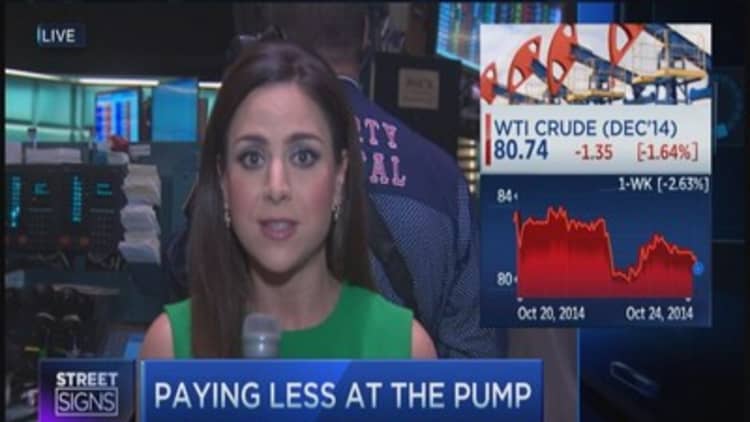A 25 percent slide in crude prices since June should mean a windfall for Asian refiners, but instead they are facing a major drag on profits.
Although benchmark Brent and West Texas Intermediate crudes are just off multi-year lows, many refiners have previously agreed to pay higher prices for deliveries through to the end of this year and can not pass those costs on to fuel buyers.
Forecasts that crude prices will remain weaker-than-expected into next year have also raised the specter of big write-downs on crude and product inventories on year-end earnings reports.
"As (the falls were) unexpected, they are causing earnings shocks," said Andrew Yoon, a senior analyst at Daishin Securities, noting the knock-on impact that cuts in oil inventory values would have on end-of-year results.
Read MoreOil could slide further, but where's the bottom?
Brent dropped to less than $83 a barrel on Oct. 16, its lowest in almost four years after falling from this year's high of $115.71 in mid-June. The front-month contract has recovered some lost ground and has held mostly above $85 since then, but it is not clear its four-month downtrend is finished.
"In terms of an impact on our inventories, cheaper oil price is a minus as it will lead to appraisal losses," said Yasushi Kimura, head of the Petroleum Association of Japan and chairman of Japan's biggest refiner JX Holdings.
A source at a Southeast Asian refiner said his company started the year with an oil complex based on a $106 price for Brent, and even if the benchmark recovers to $90, it is looking at a $16-a-barrel loss on oil in tanks.
The refiner holds about 3 million barrels of crude at any time, yielding a paper loss of around $48 million under this price scenario.

South Korea - with the fourth-largest refining capacity in Asia Pacific at 2.9 million barrels per day - held 29.5 million barrels of crude inventory by end-September, customs data shows.
That means every $10 drop in crude represents a $295 million loss in South Korea's inventory values.
South Korean refiners could also take a hit on lower values for more than 52 million barrels of oil products that state-run Korea National Oil says they held at the end of last month.
Margins and runs
SK Innovation Co, which owns SK Energy Co, South Korea's largest refiner, said it is looking into ways to minimize position risks against falling crude prices.
Read MoreDon't trust the price of oil: JP Morgan Funds strategist
Asian refiners usually do not hedge crude imports.
"We have already bought all the crude to be delivered through the year-end, considering it takes two months for most shipments," said a Seoul-based refining source who declined to be identified due to the sensitivity of the matter.
Although margins at a complex refinery in Singapore - the benchmark value for Asia - have rebounded to above $5 a barrel from an average of $3.66 a barrel in August, with refiners still waiting for high-cost crude shipments to arrive, those improvements may not hold.
"Despite the substantially lower feedstock prices, the product prices have also fallen. So margins have not really improved," said an analyst with an oil producer who declined to be named because of company policy.
Read MoreLower oil not forcing companies to cut production
"If the demand was 'solid' we should have seen some relative strength in product prices versus crude," he said.
Some Asian refiners have been striving to offset processing losses by cutting operating rates compared with a year ago, according to some sources and analysts.
Others have been holding rates flat to just slightly lower, looking to fill tanks with products refined from cheap crude that can be sold when the markets recover.
"Refiners will probably keep their runs cautious and just spoon feed, just buy enough and see how it goes," waiting until it is clear that prices have hit bottom or processing margins have turned less volatile, said the oil producer's analyst.
Read MoreU.S. gasoline cheapest in nearly four years -Lundberg survey
South Korea's September refinery utilization rate fell 6 percentage points from August, although run rates in the first nine months of the year were up 0.3 percentage point from the same period last year. Over January-August, Taiwan's throughput was down 1.3 percent from a year ago.
Chinese refiners, in contrast, bumped up their crude runs by 9.1 percent from a year ago in September, taking advantage of the sell-off in crude values to fill product tanks processed from cheap oil.
Still, demand for oil in 2015 is expected to grow far slower than previously forecast, the International Energy Agency said.
"In theory, lower oil prices would eventually stimulate demand but we still have some way to go for that to happen," said the producer's analyst.

